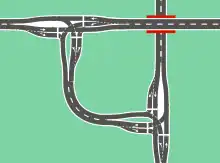Quadrant roadway intersection
A quadrant roadway intersection adds an additional "quadrant roadway" between two legs of an intersection. This roadway adds two three-way intersections in addition to the original four-way intersection, moving all left turns (in right-hand traffic countries) or right turns (in left-hand traffic countries) from the main intersection. The design is intended to improve traffic flow by reducing signal timing phases from four to two in the main intersection. The design is intended for intersections where large artery routes meet in an area of dense development and high pedestrian volume.[1][2]

Left-turning traffic is directed away from the main intersection, as exemplified by green and blue traffic: Green traffic arrives from the south and wants to turn left/west. Blue traffic arrives from the east and want to turn left/south. Left-turning traffic from the remaining two directions not shown for clarity.
Proponents also point to a reduction in places where accidents could occur from vehicles potentially crossing paths, as well as a low development cost compared to roundabouts or the more complex single-point urban interchange designs.[1][3][4] Opponents point to the increase in points where accidents could occur with merging traffic as well as the non-traditional nature of the design, which has the potential to confuse drivers. Opponents also rebut low-cost claims, pointing to right-of-way and construction costs of the quadrant road.[1][3]
A related structure known as a jughandle accomplishes similar traffic movement from a more compact shape.
Double-quadrant intersections
Single-quadrant intersections (pictured above) feature a single quadrant road.
A double-quadrant intersection (or two-quadrant intersection) adds a second quadrant road placed opposite another.[5][6][7]
Quadrant interchanges


An interchange variant of the quadrant roadway intersection links grade-separated roads, generally a faster road with denser traffic, to a less traveled, slower road, via the quadrant road. This design is referred to as a one-quadrant interchange[8] or as a single-loop intersection.[4] This type of junction is common in Germany, where it is called a "partial at-grade intersection" (German: Teilplangleicher Verkehrsknoten).[9] A so-called two-quadrant interchange also exists, which adds a second quadrant road (although the term "two-quadrant interchange" could be applied to any grade-separated junction in which there are ramps in two quadrants).[10]
Ohashi Junction in Tokyo, Japan, is also a one-quadrant interchange connecting the elevated Shibuya Route and the underground Central Circular Route of Shuto Expressway. With circular ramps built on the southwest quadrant of two expressways, the Ohashi JCT was designed in a four-leveled manner.[11]
References
- Turner-Fairbank Highway Research Center (August 2004). "Signalized Intersections: Informational Guide". ALTERNATIVE INTERSECTION TREATMENTS. United States Department of Transportation. Retrieved 3 January 2010.
- Cooke, Jordan (Mar 24, 2009). "Left turns left out of road redesign". Cary News. Archived from the original on April 10, 2009. Retrieved 3 January 2010.
- Hummer, Joseph E. (May 14, 2003). "Moving More Cars Through the Same Space Using Unconventional Intersection Designs" (PDF). NCDOT Traffic Engineering Conference. North Carolina State University. Retrieved 3 January 2010.
- "Quadrant Roadway Intersection vs. Traditional Intersection" (PDF). Community Planning Assn. of Southwest Idaho. Retrieved 3 January 2010.
- "Quadrant Roadway Intersection". Alternative Intersections/Interchanges: Informational Report (AIIR). Federal Highway Administration. April 2010. FHWA-HRT-09-060. Retrieved September 4, 2017.
- Wilbur Smith Associates; Thompson Transportation; HDR; Hummer, Joseph E., Ph.D., P.E. (April 21, 2008). "Intersection Concept Layout Report" (PDF). High Volume Intersection Study (PDF). Community Planning Association of Southwest Idaho. Retrieved September 4, 2017.
{{cite web}}: CS1 maint: multiple names: authors list (link) - Nelson, Catherine M., P.E.; Belleque, Kent; Crossler-Laird, Rich; Gutierrez, Rodger; Henson, Christopher; Lindland, Steve; Nguyen, Lily; Polly, Dave; Warrick, Dave (2012). "Chapter 2: Design Controls and Criteria" (PDF). ODOT Highway Design Manual (PDF). Oregon Department of Transportation. Retrieved September 4, 2017.
{{cite web}}: CS1 maint: multiple names: authors list (link) - "Archived copy" (PDF). Archived from the original (PDF) on April 12, 2015. Retrieved December 23, 2014.
{{cite web}}: CS1 maint: archived copy as title (link) - Institut für Straßen- und Eisenbahnwesen am KIT: Entwurf und Bau von Straßen – Teil: Straßenentwurf. (PDF; 8,44 MB) Retrieved 7 September 2013.
- Maze, T.H.; Hochstein, Joshua L.; Souleyrette, Reginald R.; Preston, Howard; Storm, Richard (2010). Appendix A, Detailed Green Book Review with Comments (PDF). doi:10.17226/22958. ISBN 978-0-309-43543-7. Project Number 15-30. Retrieved September 12, 2017.
{{cite book}}:|work=ignored (help) - Metropolitan Expressway Company Limited (July 19, 2013). "大橋"グリーン"ジャンクションの環境への取組み" [Dealing with the Environment of Ōhashi "Green" Junction] (PDF). 道路行政セミナー [Road Administration Seminar]. Highway Industry Development Organization (HIDO) (58). Archived from the original (PDF) on February 14, 2023. Retrieved February 14, 2023.